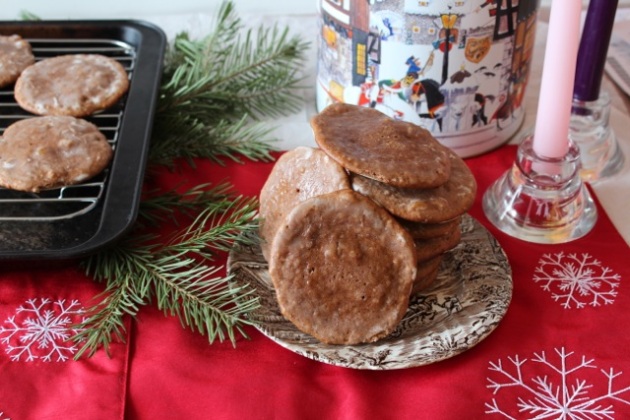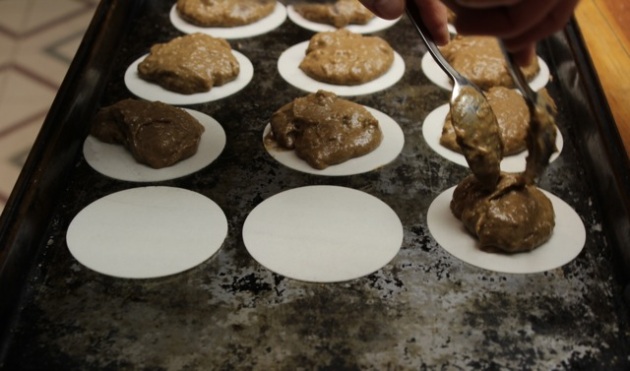In preparation for the Holiday Season, Stella likes to come up with a few new offerings at her cafe. She gets a great deal of satisfaction out of customers coming in, looking at the baked goods in the glass front case and saying, “That looks really good, can I try one of those?” Stella has learned that in the cafe business the way baked goods look is almost as important as how they taste.
Last year, Stella thought she might have a brand new kind of soft baked spice cookie for her customers, a kind rarely seen outside of Germany or European specialty shops: Lebkucken, which is baked onto a crispy wafer called Oblaten. After spending several hours poring over the internet, she had decided on a recipe from a German food site. The website claimed its particular recipe was close to the type of Lebkucken, a specialty that goes back to Medieval times, found in the Christmas markets of Nuremberg. She purchased the ingredients and spent an evening preparing a good-sized batch of the spicy iced cookies. She mixed up the dough and put the suggested three tablespoon mounds a few inches apart on parchment paper lined cookie sheets, because she had not found the Oblaten wafers the recipe asked for. The dough was the ugliest she’d ever seen. She likened it to something better left to the imagination, but it smelled good, so she kept up her faith in the process.
As the cookies had baked she already knew they needed more of the special spice mixture, and she feared they would be bland. Texture-wise, the cookies turned out textbook perfect, but they were still not very pretty. Next, she had turned her attention to the boiled icing flavoured with orange liqueur, following the directions to the letter. ‘Boil the sugar and water for a few minutes…” she muttered to herself as she stirred the mixture. What exactly was ‘a few minutes’? Three? Seven? Nine? She decided to err on the side of caution and boil it for three. The icing was meant to be brushed on the cookies when warm, and she knew a nice, glossy icing could rescue the Lebkuchen more than anything. Better make it thin. When the mixture looked right, she took it off the heat and sifted the required amount of confectioners sugar into it. Within seconds the icing was more like fudge than glaze. She spread it on the cookies as quickly as possible. The result? Quite possibly the lumpiest, homeliest cookies ever known. This would not do! Despite their unfortunate appearance, Stella and her girls had eaten the Lebkuchen with tea, proclaiming it, ‘Not bad.’
This year, Stella had better luck. She doubled the spice, found Oblaten wafers at a German import warehouse and had much better success with the glaze. The Lebkuchen still were not very pretty, but they had a tasty, unique combination of flavours and she and many of her customers enjoyed them very much.
“I hope you are going to make these again!” said June, one of her vivacious elderly regulars who was always ready to try anything new, provided it was vegetarian.
“Next year, they will be even better,” said Stella in response.
Lebkucken
Dough:
- 1/2 cup softened butter
- 1 cup sugar
- 4 eggs
- 3 cups white flour
- 2 Tablespoons Lebkuchen spice (see below)
- 2 Tablespoons cocoa, preferably Dutch processed
- 1 and 1/2 teaspoons baking powder
- 1 cup milk
- 1 3/4 cup ground almonds
- 1/2 cup candied lemon or citrus peel, chopped
- 1 Tablespoon rum or orange liqueur such as Cointreau or Grand Marnier
Glaze: (double the recipe if you like a slightly thicker glaze more like icing)
- 1/4 cup granulated sugar
- 1/4 cup water
- 1/4 teaspoon vanilla
- 1/2 teaspoon orange liqueur or rum
- 2 Tablespoons powdered sugar
Optional:
- Oblaten wafers
- 1/2 cup raisins, soaked in rum and chopped
- 1/4 cup shredded coconut
Lebkuchen spices: if you cannot find the premixed ‘Lebkucken Gewurz’ from a German store, mix your own with:
- 2 Tablespoons ground cinnamon
- 2 teaspoons ground cloves
- 1/2 teaspoon ground allspice
- 1/4 teaspoon ground nutmeg
- 1/2 teaspoon ground coriander
- 1/2 teaspoon ground cardamom
- 1/2 teaspoon ground ginger
- 1/2 teaspoon ground anise seed
Method:
Cream butter, sugar and eggs together until light and fluffy.
Mix in flour, spices, cocoa powder and baking powder together and add to butter mixture, alternating with milk.
Fold in nuts and lemon peel. Stir in rum or liqueur. Stir in raisins and coconut if using them. Dough will be more like cake batter than cookie dough. Just make sure it isn’t too runny. If it is, add a little more flour, a Tablespoon at a time until it is your desired consistency.
If you are not using the Oblaten, which look like large communion wafers, draw 3 inch diameter circles on parchment paper using a cup or biscuit cutter as a template.
Drop about 2-3 tablespoons cookie dough into the center of each circle. (If you are using the Oblaten drop the dough onto the wafer and smooth to the edges.) When the tray is full, use the back of the spoon to fill out the circle, slightly mounding the dough towards the center.
Bake at 375 degrees Farenheit for 15-20 minutes. Turn oven down to 350 if cookies are browning too much.
Let cool for a few minutes, then remove to a cookie or cake rack to cool.
While they are still warm, make the glaze:
Place 1/4 cup sugar and 1/4 cup water in a small saucepan on the stove. Bring to a boil and boil gently for 2 minutes. Remove from heat. Add 1/4 teaspoon vanilla, and 1/2 teaspoon liqueur or rum. Sift 2 Tablespoons powdered sugar over sugar syrup and whisk. Adjust ingredients until you have a spreadable, but not watery glaze. Brush on cookies.
Note: Stella altered the glaze ingredients from the original recipe. In another recipe she found the glaze was merely a cup of icing sugar and 2 Tablespoons of boiling water. It may take some experimenting to get the glaze, and the cookies, the way you like them.
Have fun and enjoy the results! If you have a Lebkuchen recipe you would like to share with Stella, please do.


